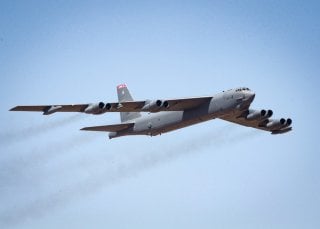Get Ready to Celebrate a Century of the B-52 Bomber
The Air Force has not yet found all the money for the B-52 upgrade program.
Here's What You Need to Remember: "To keep the airplane flying, the service plans to equip each B-52 with new engines, which are expected to be so much more maintainer-friendly and efficient that they’ll pay for themselves in just 10 years."
Sixty-seven years after the U.S. Air Force received its last B-52 from Boeing, the flying branch finally has firmed up plans to fit the heavy bomber with new engines.
Air Force magazine in its January 2019 issue took a deep dive into the re-engining effort.
"If Air Force plans hold up, the B-52 will be approaching nearly a century of service by 2050," reporter John Tirpak wrote. "To keep the airplane flying, the service plans to equip each B-52 with new engines, which are expected to be so much more maintainer-friendly and efficient that they’ll pay for themselves in just 10 years."
In addition to new motors, the 76 B-52s in Air Force service also could get upgraded avionics, defensive gear, sensors and ejection seats, War Zone reporter Joe Trevithick revealed. The re-engined, enhanced bombers could receive the new designation B-52J.
In 2018, the Air Force announced it would retire its 62 1980s-vintage B-1Bs bombers and 20 newer B-2 stealth bombers no later than the 2040s, while the updated B-52s would continue to operate alongside at least 100 new B-21 stealth bombers.
“Despite their age, the B-52s have high mission-capable rates, can carry a huge diversity of weapons, and can perform effectively—as long as the enemy lacks elaborate air defenses,” Tirpak wrote. “Even in a higher-end fight, the B-52 can still launch missiles from well outside enemy air defenses. It is the only U.S. bomber that can launch nuclear cruise missiles, and it will be the initial platform for the new Long-Range Stand-Off missile.”
It took two decades of debate for the B-52 upgrade plan to reach this point. Since 1996 the Air Force has conducted no fewer than 13 studies examining options for new motors for the 240-ton bomber. As of early 2019 the B-52H still flies with the same Pratt & Whitney-made TF-33 engines that have powered the type since 1962.
A 2018 Air Force briefing cited the TF-33's "inefficient and limited capability relative to modern commercially-available engines." The Pratt & Whitney motors are "costly and manpower-intensive to maintain [while] facing obsolescence of parts."
"Modern engines are so much more reliable than the TF-33s that were once installed, the new engines will probably never have to be removed," Tirpak wrote. "The meantime between overhauls for that class of engines is typically around 30,000 hours—greater than the number of hours the service plans to fly the bombers for the rest of their service lives."
The goal in replacing the engines is to improve the B-52's fuel-efficiency by at least 20 percent while maintaining its ceiling and take-off performance. A B-52H with TF-33 engines can carry 35 tons of bombs and missiles as far as 4,500 miles without aerial refueling at a top speed of 650 miles per hour.
"Despite rumors to the contrary, Isabelle said the Air Force is not looking for substantially better physical performance from the new engines—for example, in time-to-climb or top speed—although that may turn out to be a welcome by-product," Tirpak explained.
The Air Force in 2018 estimated the cost of B-52 service-life extension—including the re-engining other capability improvements—at around $32 billion, according to Tirpak.
Between 2011 and 2016 it cost the Air Force around $1.2 billion annually to operate 76 B-52s, the Government Accountability Office reported in 2018.
More efficient engines could save $10 billion in fuel and maintenance costs through the 2040s, Tirpak reported, citing Air Force documents. The service wants 608 engines -- eight for each B-52.
The Air Force has not yet found all the money for the B-52 upgrade program. “We are working through our leadership to develop a strategy on how to approach the acquisition,” James Hunsicker, the service’s deputy chief of bomber requirements, told Tirpak.
The Air Force tapped Boeing to integrate the new motors. Pratt & Whitney, General Electric and Rolls-Royce all have proposed engine types for the B-52 effort. The Air Force in 2017 stated it would test new engines on two B-52s as early as 2022, select a contractor before 2026 and complete the re-engining project before 2034.
David Axe served as Defense Editor of the National Interest. He is the author of the graphic novels War Fix, War Is Boring and Machete Squad.
This article is being republished due to reader interest.
Image: Flickr

